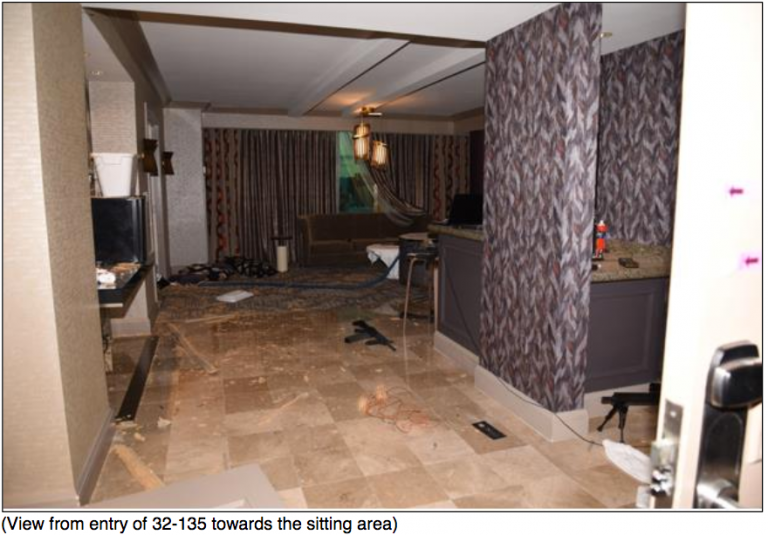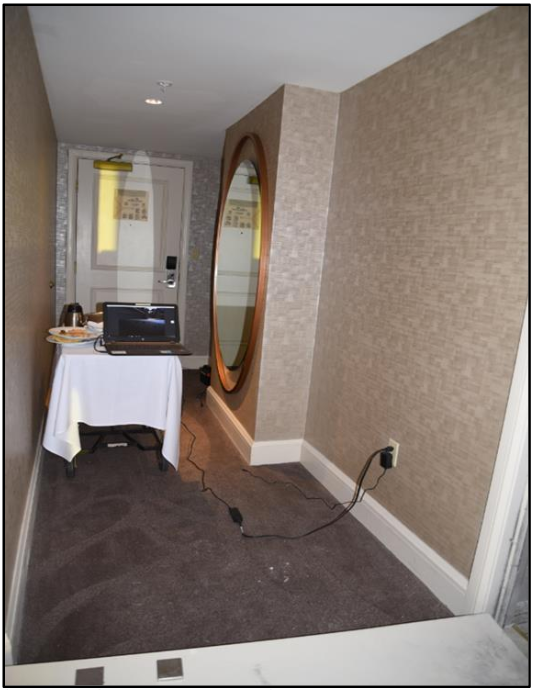Was Stephen Paddock the only person in room during shooting spree
LAS VEGAS — One of the biggest questions since the October 1 Las Vegas mass shooting has been was whether Stephen Paddock was the lone shooter inside Mandalay Bay Resort Casino rooms 32-135 and 32-134 during the time the gunfire was reigning down into the Route 91 Music Festival.
Did he have assistance from anyone else inside his rooms?
Was he killed by an accomplice(s) prior to and or after the shooting stopped and did that accomplice(s) escape sometime during the time frame before the police breached the suite over an hour after the last shots were fired?
I, like many others, have been pondering those questions for nine months and have asked in numerous stories that I have authored for the Baltimore Post-Examiner for the Las Vegas Metropolitan Police Department to immediately release the lock interrogation reports for both rooms.
To date, those lock interrogation reports have not been released.
LVMPD Detective S. Baker stated in his Officer’s Report that on October 1, 2017: “Upon arrival at the security office we coordinated with security to get room information for Stephen Paddock, conduct initial lock interrogations for these rooms as well as beginning to obtain all security and surveillance video containing the suspect, as well as attempting to determine if Paddock had coordinated or arrived at the hotel with any other individuals.”
The LVMPD released their Preliminary Investigative Report on January 19, which also contained several crime scene photographs of rooms 32-134 and 32-135.
On Page 11 of the Report it states that at approximately 2136 hours, the deadbolt to room 32-135 was engaged. At approximately 2146 hours, the deadbolt to room 32-134 was engaged.
That information, according to the Report was obtained from the lock interrogation reports that were conducted for both rooms.
A lock interrogation report is obtained by downloading the data that is stored inside each individual door lock on hotel guest rooms. Every time a key card is placed into the electronic door lock to access the room door, information that is stored includes the type of key card, i.e. guest, housekeeping, maintenance, etc., the time/date the key card was used to access the room among other data. The lock interrogation will also indicate if the deadbolt was engaged/disengaged and if the door opened.
A hotel guest can only engage the deadbolt manually and then only from inside their room.
As I have written in several stories, the lock interrogation, specifically in this case is vital in determining that after the deadbolts were engaged to rooms 32-135 and 32-134 at 9:36 p.m. and 9:36 p.m. respectively, whether either one of the deadbolts were disengaged after the gunfire stopped, and did either door open, prior to the door breach by the police at 11:20 p.m. on October 1st.
If that happened, then that would indicate that someone could have left either one of those rooms prior to the police breaching the room.
The Preliminary Investigative Report only indicates that the deadbolts were engaged. There is no mention of whether they remained engaged until the breach at 11:20 p.m. That information should have been contained in the Report, as it would have prevented many speculative theories from arising.
So, without the actual lock interrogation reports, what do we have to indicate whether the deadbolts were engaged or disengaged at the time of the breach?
Th answer may be in the crime scene photographs that were released as part of the Preliminary Investigative Report. Then again, maybe not.
I have to question why those official LVMPD crime scene photographs do not have a time/date stamp. We also have not seen any police video of the interior of both rooms that was most likely video recorded by the crime scene investigators.

Photograph #1 is a view from the front door entrance of 32-135. Note the door lock seen in the foreground. The deadbolt is engaged. The time/date this photo was taken is unknown, but it was obviously taken sometime after the door breach.

Photograph #2 shows the same exact door from the inside view. Notice the deadbolt. It is now disengaged. The deadbolt knob is at the 12 o’clock position which confirms the deadbolt is disengaged. The time/date this photo was taken is also unknown.
We have two LVMPD official crime scene photographs of the same door that indicate two entirely different scenes. Which one depicts the correct position of the deadbolt as it was when the door was explosively breached cannot be determined by either one of these photographs.
The door deadbolt lock, which is evidence, was tampered with, whether it was engaged or disengaged we don’t know. That is not only troubling but is not acceptable police procedure during any criminal investigation, much less the investigation of the worst mass shooting in modern American history.

Photograph #3 is another LVMPD crime scene photograph that depicts a view of the room entry door to 32-134 from inside the room. I zoomed in on the door lock as best I could, and it appears that the deadbolt knob is facing to the right which would indicate that the deadbolt on this door is engaged.

Photograph #4 is another photograph of the entry door to room 32-135 covered with crime scene tape. This photograph was taken allegedly by a civilian photographer who entered the crime scene area and snapped the photo which then made national news on October 3, 2017. The deadbolt is also disengaged in this photograph as well.
I strongly hope for the sake of the families of the 58 killed and the survivors of the October 1st mass shooting, that when the LVMPD decides in their infinite wisdom, to release the lock interrogation reports, that those reports will confirm that the deadbolts never disengaged on either door and therefore would prove that Stephen Paddock was the lone shooter inside those rooms and that no one could have possibly left those rooms short of flying out a window.

Doug authored over 135 articles on the October 1, 2017, Las Vegas Massacre, more than any other single journalist in the country. He investigates stories on corruption, law enforcement, and crime. Doug is a US Army Military Police Veteran, former police officer, deputy sheriff, and criminal investigator. Doug spent 20 years in the hotel/casino industry as an investigator and then as Director of Security and Surveillance. He also spent a short time with the US Dept. of Homeland Security, Transportation Security Administration. In 1986 Doug was awarded Criminal Investigator of the Year by the Loudoun County Sheriff’s Office in Virginia for his undercover work in narcotics enforcement. In 1991 and 1992 Doug testified in court that a sheriff’s office official and the county prosecutor withheld exculpatory evidence during the 1988 trial of a man accused of the attempted murder of his wife. Doug’s testimony led to a judge’s decision to order the release of the man from prison in 1992 and awarded him a new trial, in which he was later acquitted. As a result of Doug breaking the police “blue wall of silence,” he was fired by the county sheriff. His story was featured on Inside Edition, Current Affair and CBS News’ “Street Stories with Ed Bradley”. In 1992 after losing his job, at the request of the Federal Bureau of Investigation, Doug infiltrated a group of men who were plotting the kidnapping of a Dupont fortune heir and his wife. Doug has been a guest on national television and radio programs speaking on the stories he now writes as an investigative journalist. Catch Doug’s Podcast: @dougpoppa1

